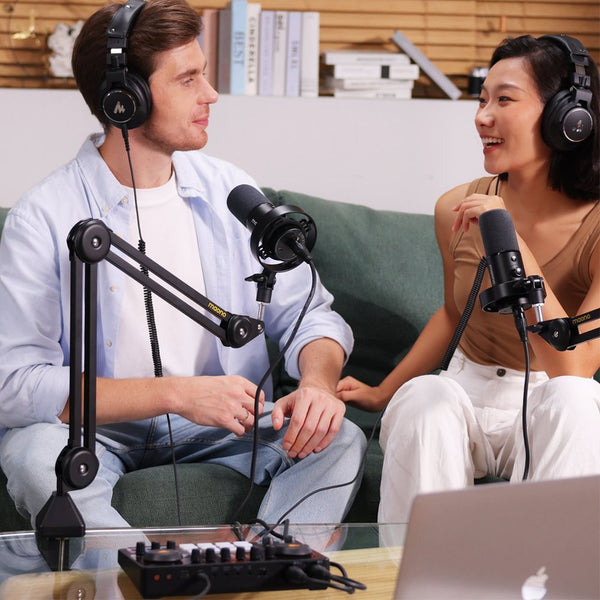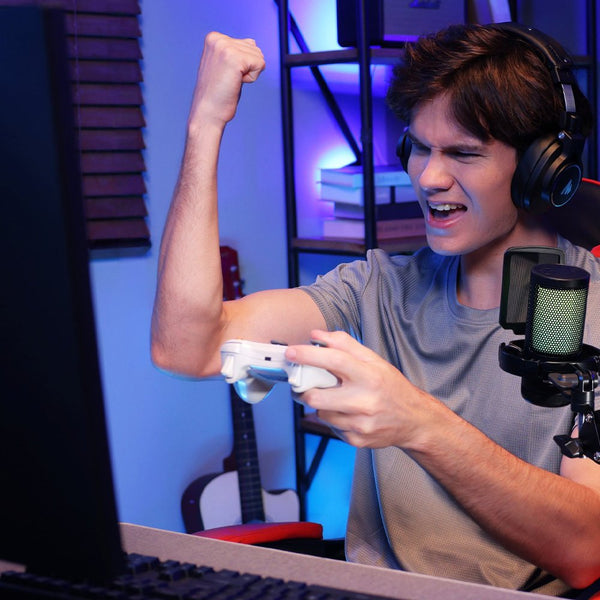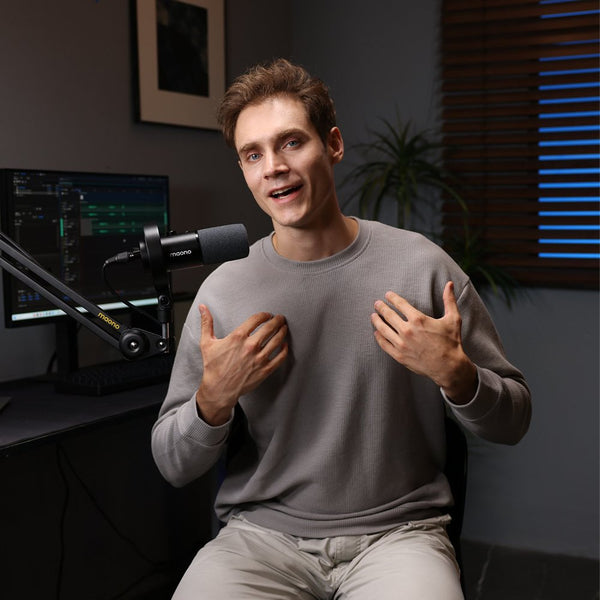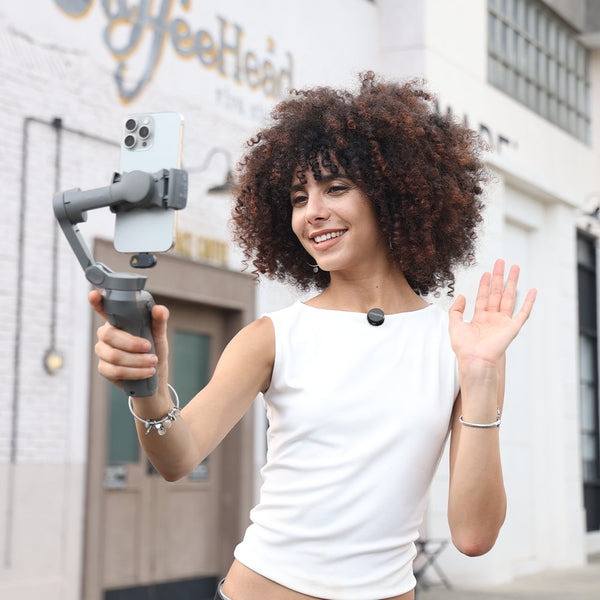If you're in a situation where you need to decide whether to create video podcasts or audio-only podcasts, you should ask yourself some key questions, such as: "Is this what I need, or am I just following a trend?" or "Will my show actually benefit from visuals?" and "Is my podcast more of an online show for promotion, or a podcast meant to lead people to download and subscribe?"
People who consume audio-only podcasts do so for a reason. They likely want to listen to something while doing other things—like working out, cooking, or folding laundry. There are times when watching visuals simply isn't practical.
In this article, we'll differentiate between the two formats: audio-only podcasts and video podcasts.
Podcasting has exploded in popularity over the past decade, offering creators and brands a unique way to connect with their audiences. But if you're just getting started—or thinking of revamping your current show—one major decision stands in your way: Should you go with audio-only or video podcasting?
Choosing between an audio-only podcast and a video podcast depends on your goals, resources, and audience preferences. Each format offers distinct advantages and challenges. The key is knowing what suits your message and workflow best.
At the heart of both formats is audio quality—and that’s where dynamic podcast mics come in. Whether you’re on-camera or not, clear and professional sound is non-negotiable. But are USB/XLR mics truly reliable for podcasting, especially if you're a beginner or on a budget? We’ll cover that too.
But beyond format decisions, podcasters also face a crucial technical consideration: What microphone is best for your show? In particular, dynamic USB/XLR microphones like the Maono PD400X and Maono PD300X have become popular choices for their reliability, flexibility, and audio clarity. These are some of the best podcast mics available today for creators seeking pro-level audio on a budget.
This article will help you explore the pros and cons of each podcast format, understand how audience behavior varies, and recommend the best dynamic microphones to get you started or upgrade your podcast mic setup.
Is Audio-Only Still Relevant in the Age of Video Podcasts?
Despite the growing popularity of video podcasts, audio-only is far from obsolete. In fact, audio remains the preferred format for many listeners due to its convenience. People tune in during workouts, commutes, while cooking, or even before bed—activities that don’t always allow for watching a screen.
According to Edison Research’s Infinite Dial report, millions of listeners continue to engage with podcasts primarily through platforms like Spotify and Apple Podcasts, proving that audio-only content still thrives in today’s digital landscape.
Which Format Is Better for Beginner Podcasters: Audio or Video?
For beginners, audio-only podcasting is generally easier to start with. It requires fewer resources—no camera gear, lighting setups, or video editing software. You can launch an audio podcast using just a mic for podcast, headphones, and free editing software like Audacity or GarageBand.
However, if you're comfortable in front of a camera and want to reach both YouTube viewers and audio listeners, video podcasting can provide broader exposure. Just be prepared for a steeper learning curve and increased time investment.
How Does Audience Behavior Vary Between Audio and Video Content?
Audio podcast listeners often multitask. They seek content that’s engaging yet portable, something that fits seamlessly into their daily routines. Episodes with compelling storytelling, interviews, or educational value do particularly well.
On the other hand, video podcast audiences are more likely to engage visually. They expect on-screen interaction, visual cues, facial expressions, and sometimes graphics or screen shares. Video works well for personality-driven shows, tutorials, behind-the-scenes content, or interviews that benefit from visual context.
Understanding how your audience consumes content is critical to choosing the right format.
How Do Editing Needs Differ Between Audio and Video Podcasts?
Editing an audio podcast is more straightforward. You’ll trim filler words, remove background noise, and balance levels. Tools like Descript, Adobe Audition, or Reaper streamline this process.
Video podcast editing, on the other hand, involves syncing audio and video, cutting between camera angles, adding overlays or lower thirds, and color correcting footage. Software like Final Cut Pro, Adobe Premiere Pro, or DaVinci Resolve is typically required.
In short, video editing is more time-consuming and resource-intensive than audio editing.
Is It Easier to Produce an Audio Podcast Compared to a Video One?
Yes—audio podcasts are significantly easier to produce. They require less equipment, take less time to edit, and offer more flexibility in terms of recording environment. You don’t need perfect lighting or a camera-ready space. In fact, some of the best audio podcasts are recorded in small home studios or even closets using a basic podcast mic kit.
Producing a video podcast means investing in cameras, lighting, backdrops, and possibly multiple microphones for syncing. You’ll also need more storage and processing power for editing large video files.
Does a Video Podcast Help Grow Your Brand Faster Than Audio?
In many cases, video podcasts can accelerate brand visibility—especially when hosted on platforms like YouTube, TikTok, or Instagram Reels. These platforms promote discovery through algorithms, which can expose your show to new audiences.
Video content also tends to perform better on social media, making it easier to repurpose clips for promotion. If building a personal brand or visually showcasing your content is a key goal, video can be a strong choice.
However, audio-only podcasts often enjoy deeper listener loyalty and higher completion rates, which are crucial for building a committed community. Audio listeners tend to spend more time per episode compared to video viewers who may skim or multitask.
Is There a Difference in Hosting Platforms for Audio vs. Video Podcasts?
Yes. Audio podcasts are traditionally hosted on platforms like:
-
Buzzsprout
-
Podbean
-
Libsyn
-
Anchor (Spotify for Podcasters)
These services distribute your podcast across Spotify, Apple Podcasts, Google Podcasts, and more.
Video podcasts, however, rely on platforms like:
-
YouTube
-
Vimeo
-
Facebook Video
-
Spotify (with video podcast support)
Some podcasters publish audio and video separately, while others host both on Spotify, which now supports video episodes. If you want maximum reach, you may need to use both types of hosting platforms.
Can I Record Both Audio and Video Versions of the Same Podcast Episode?
Absolutely. In fact, many successful podcasters do just that. Recording both formats allows you to:
-
Upload the video version to YouTube or Spotify
-
Offer an audio-only version to podcast apps
-
Repurpose short clips for TikTok, Instagram, and Facebook
Just make sure your setup captures high-quality audio, even for the video version. Use external mics instead of relying on camera audio. A good mic for podcasting makes all the difference, even when visuals are involved.
Best Budget-Friendly Dynamic USB/XLR Mics for Two-Person Podcasts
When it comes to podcasting gear, your microphone is your most important investment. If you're running a two-person podcast mic setup, especially from home or on a budget, dynamic USB/XLR microphones offer the ideal balance of affordability, quality, and flexibility.
- Maono PD400X – The Versatile Powerhouse
The Maono PD400X is a dual USB/XLR dynamic microphone built for modern podcasters. It combines professional sound quality with user-friendly design and versatile connectivity.
Features:
-
USB and XLR outputs for flexible use with computers or mixers.
-
3-in-1 multi function knob, Built-in gain, one tap mute, and headphone volume controls.
-
Cardioid pickup pattern that reduces background noise.
-
High sensitivity for crisp, detailed vocal recording.
-
Comes with a sturdy desktop stand or boom arm (your choice).
Why it’s great: Whether you're podcasting solo or with a guest, the Maono PD400X gives you studio-level performance without the complicated setup. It’s ideal for growing podcasters who may want to upgrade to an audio interface later but still want plug-and-play simplicity now.
2. Maono PD300X – Budget-Friendly and Broadcast-Ready
The Maono PD300X is a fantastic option for podcasters who want quality on a tight budget. It's designed with beginners and two-person podcast setups in mind.
Features:
-
USB, USB-C, XLR connectivity with onboard controls.
-
Dynamic capsule that blocks unwanted room noise.
-
3-in-1 smart knob with mute button
-
Features quick mute and noise reduction
Why it’s great: The Maono PD300X is simple to use, sounds great out of the box, and is one of the best mics under $100 for podcasting. It’s especially helpful for recording in untreated spaces or busy home environments thanks to its noise-rejecting design.
Both mics work great for two-person podcasts — just connect each to a laptop (USB) or interface (XLR) and you’re ready to roll with clean, professional audio.
Conclusion
Choosing between an audio-only or video podcast isn’t about which is better in general—it’s about what works best for your audience, brand, and workflow.
If you’re just starting out, audio may be the easiest path, offering simplicity and flexibility. If your content benefits from visual storytelling, and you're comfortable on camera, video podcasting opens doors to greater reach and discoverability.
Whichever format you choose, remember that great audio quality is non-negotiable. A reliable, budget-friendly mic for podcast—especially for multi-person setups—can elevate your podcast’s professionalism and keep your audience engaged.
In the end, you don’t have to choose just one. Many successful creators record in both formats and deliver a seamless experience across platforms. So consider your goals, test what works, and above all—start creating.



